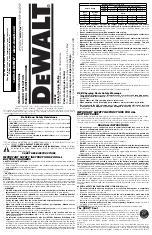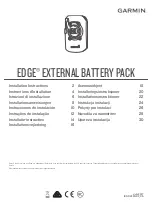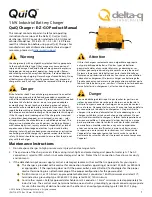
Defi nitions: Safety Guidelines
The definitions below describe the level of severity for each signal word. Please read
the manual and pay attention to these symbols.
DANGER:
Indicates an imminently hazardous situation which, if not avoided,
will
result in
death or serious injury
.
WARNING:
Indicates a potentially hazardous situation which, if not avoided,
could
result in
death or serious injury
.
CAUTION:
Indicates a potentially hazardous situation which, if not avoided,
may
result in
minor or moderate injury
.
NOTICE:
Indicates a practice
not related to personal injury
which, if not avoided,
may
result in
property damage
.
IF YOU HAVE ANY QUESTIONS OR COMMENTS ABOUT THIS OR ANY D
E
WALT TOOL, CALL
US TOLL FREE AT:
1-800-4-D
E
WALT (1-800-433-9258)
.
WARNING! Read and understand all instructions.
Failure to follow
all instructions listed below may result in electric shock, fire and/or
serious personal injury.
SAVE THESE INSTRUCTIONS
IMPORTANT SAFETY INSTRUCTIONS FOR ALL
BATTERY CHARGERS
SAVE THESE INSTRUCTIONS:
This manual contains important safety and operating instructions
for battery chargers.
• Before using the charger, read all instructions and cautionary markings on the charger, battery
pack and product using the battery pack.
WARNING:
Shock hazard. Do not allow any liquid to get inside the charger. Electric shock may
result.
CAUTION:
Burn hazard. To reduce the risk of injury, charge only D
E
WALT rechargeable battery
packs. Other types of batteries may overheat and burst resulting in personal injury and property
damage.
NOTICE:
Under certain conditions, with the charger plugged into the power supply, the charger can
be shorted by foreign material. Foreign materials of a conductive nature, such as, but not limited
to, grinding dust, metal chips, steel wool, aluminum foil or any buildup of metallic particles should be
kept away from the charger cavities. Always unplug the charger from the power supply when there
is no battery pack in the cavity. Unplug the charger before attempting to clean it.
WARNING:
•
DO NOT attempt to charge the battery pack with any chargers other than the ones in
this manual.
The charger and battery pack are specifically designed to work together.
•
These chargers are not intended for any uses other than charging D
E
WALT
rechargeable batteries.
Any other uses may result in risk of fire, electric shock or electrocution.
•
Do not expose the charger to rain or snow.
•
Pull by the plug rather than the cord when disconnecting the charger.
This will reduce
the risk of damage to the electric plug and cord.
•
Make sure that the cord is located so that it will not be stepped on, tripped over or
otherwise subjected to damage or stress.
•
Do not use an extension cord unless it is absolutely necessary.
Use of improper extension
cord could result in risk of fire, electric shock or electrocution.
•
When operating a charger outdoors, always provide a dry location and use an
extension cord suitable for outdoor use.
Use of a cord suitable for outdoor use reduces the
risk of electric shock.
•
An extension cord must have adequate wire size (AWG or American Wire Gauge) for
safety.
The smaller the gauge number of the wire, the greater the capacity of the cable, that is,
16 gauge has more capacity than 18 gauge. An undersized cord will cause a drop in line voltage
resulting in loss of power and overheating. When using more than one extension to make up
the total length, be sure each individual extension contains at least the minimum wire size. The
following table shows the correct size to use depending on cord length and nameplate ampere
rating. If in doubt, use the next heavier gauge. The lower the gauge number, the heavier the cord.
Minimum Gauge for Cord Sets
Ampere Rating
Volts
Total Length of Cord in Feet (meters)
120V
25 (7.6)
50 (15.2)
100 (30.5)
150 (45.7)
240V
50 (15.2)
100 (30.5)
200 (61.0)
300 (91.4)
More
Than
Not More
Than
AWG
0
6
18
16
16
14
6
10
18
16
14
12
10
12
16
16
14
12
12
16
14
12
Not Recommended
•
Do not place any object on top of the
charger or place the charger on a soft surface
that might block the ventilation slots and result in excessive internal heat.
Place the
charger in a position away from any heat source. The charger is ventilated through slots in the
top and the bottom of the housing.
•
Do not operate the charger with a damaged cord or plug.
•
Do not operate the charger if it has received a sharp blow, been dropped or otherwise
damaged in any way.
Take it to an authorized service center.
•
Do not disassemble the charger; take it to an authorized service center when service or
repair is required.
Incorrect reassembly may result in a risk of electric shock, electrocution or fire.
•
Disconnect the charger from the outlet before attempting any cleaning. This will
reduce the risk of electric shock.
Removing the battery pack will not reduce this risk.
•
NEVER
attempt to connect 2 chargers together.
•
The charger is designed to operate on standard 120V household electrical power. Do
not attempt to use it on any other voltage.
This does not apply to the vehicular charger.
• This Class B digital apparatus complies with Canadian ICES-003.
• This device complies with Part 15 of the FCC Rules. Operation is subject to the following two
conditions:
1) This device may not cause harmful interference, and
2) This device must accept any interference received, including interference that may cause
undesired operation.
NOTE:
This equipment has been tested and found to comply with the limits for a Class B digital
device, pursuant to Part 15 of the FCC Rules. These limits are designed to provide reasonable
protection against harmful interference in a residential installation. This equipment generates,
uses and can radiate radio frequency energy and, if not installed and used in accordance with
the instructions, may cause harmful interference to radio communications. However, there is no
guarantee that interference will not occur in a particular installation. If this equipment does cause
harmful interference to radio or television reception, which can be determined by turning the
equipment off and on, the user is encouraged to try to correct the interference by one or more
of the following measures:
– Reorient or relocate the receiving antenna.
– Increase the separation between the equipment and receiver.
– Connect the equipment into an outlet on a circuit different from that to which the receiver is
connected.
– Consult the dealer or an experienced radio/TV technician for help.
USB Charging Ports Safety Warnings
•
The USB charging ports are not intended for any uses other than supplying power/
charging small USB electronics.
Any other uses may result in risk of fire, electric shock or
electrocution.
•
Do not expose the USB charging ports to rain or snow.
•
When operating the USB charging ports outdoors, always provide a dry location.
•
Do not operate the USB charging ports if the jobsite charging station has received
a sharp blow, been dropped or otherwise damaged in any way.
Take it to an authorized
service center.
IMPORTANT SAFETY INSTRUCTIONS FOR ALL
BATTERY PACKS
When ordering replacement battery packs, be sure to include the catalog number and voltage.
Consult the chart at the end of this manual for compatibility of chargers and battery packs.
The battery pack is not fully charged out of the carton. Before using the battery pack and charger,
read the safety instructions below and then follow charging procedures outlined.
READ ALL INSTRUCTIONS
•
Do not charge or use the battery pack in explosive atmospheres, such as in the
presence of flammable liquids, gases or dust.
Inserting or removing the battery pack from
the charger may ignite the dust or fumes.
• NEVER force the battery pack into the charger. DO NOT modify the battery pack in any
way to fit into a non-compatible charger as battery pack may rupture causing serious
personal injury.
Consult the chart at the end of this manual for compatibility of batteries and
chargers.
• Charge the battery packs only in designated D
E
WALT chargers.
•
DO NOT
splash or immerse in water or other liquids.
• Do not store or use the tool and battery pack in locations where the temperature may
reach or exceed 105 °F (40 °C) (such as outside sheds or metal buildings in summer).
For best life store battery packs in a cool, dry location.
NOTE:
Do not store the battery pack in a tool with the trigger switch locked on. Never tape the
trigger switch in the ON position.
WARNING: Fire hazard. Do not store or carry the
battery pack so that metal objects
can contact exposed battery terminals.
For example, do not place the battery pack in
aprons, pockets, tool boxes, product kit boxes, drawers, etc., with loose nails, screws, keys, etc.
Transporting batteries can possibly cause fires if the battery terminals inadvertently
come in contact with conductive materials such as keys, coins, hand tools and the like.
The US Department of Transportation Hazardous Material Regulations (HMR) actually prohibit
transporting batteries in commerce or on airplanes (e.g., packed in suitcases and carry-on luggage)
UNLESS they are properly protected from short circuits. So when transporting individual battery
packs, make sure that the battery terminals are protected and well insulated from materials that
could contact them and cause a short circuit.
WARNING:
Fire hazard. Never attempt to open the slide battery pack for any reason. If the
slide battery pack case is cracked or damaged, do not insert into the charger. Do not crush, drop
or damage the
slide battery pack. Do not use a slide battery pack or charger that has received a
sharp blow, been dropped, run over or damaged in any way (e.g., pierced with a nail, hit with a
hammer, stepped on). Damaged slide battery packs should be returned to the service center for
recycling.
SPECIFIC SAFETY INSTRUCTIONS FOR LITHIUM ION (Li-Ion)
•
Do not incinerate the battery pack even if it is severely damaged or is completely
worn out.
The battery pack can explode in a fire. Toxic fumes and materials are created when
lithium ion battery packs are burned.
•
If battery contents come into contact with the skin, immediately wash area with
mild soap and water.
If battery liquid gets into the eye, rinse water over the open eye for
15 minutes or until irritation ceases. If medical attention is needed, the battery electrolyte is
composed of a mixture of liquid organic carbonates and lithium salts.
•
Contents of opened battery cells may cause respiratory irritation.
Provide fresh air. If
symptoms persist, seek medical attention.
WARNING:
Burn hazard. Battery liquid may be flammable if exposed to spark or flame.
The RBRC™ Seal
The RBRC™ (Rechargeable Battery Recycling Corp
oration) Seal on the nickel
cadmium, nickel metal hydride or lithium ion batteries (or battery packs) indicate that
the costs to recycle these batteries (or battery packs) at the end of their useful life
have already been paid by D
E
WALT. In some areas, it is illegal to place spent nickel
cadmium, nickel metal hydride or lithium ion batteries in the trash or municipal solid
waste stream and the RBRC program provides an environmentally conscious
alternative.
RBRC™, in cooperation with D
E
WALT and other battery users, has established programs in the
United States and Canada to facilitate the collection of spent nickel cadmium, nickel metal hydride
or lithium ion batteries. Help protect our environment and conserve natural resources by returning
the spent nickel cadmium, nickel metal hydride or lithium ion batteries to an authorized D
E
WALT
D
E
WALT Industrial Tool Co., 701 East Joppa Road, Towson, MD 21286
(MAR14) Part No. N362359 DCB102 Copyright © 2014 D
E
WALT
The following are trademarks for one or more D
E
WALT power tools: the yellow and black color scheme; the
“D” shaped air intake grill; the array of pyramids on the handgrip; the kit box configuration; and the array of
lozenge-shaped humps on the surface of the tool.
INSTRUCTION MANUAL
GUIDE D’UTILISA
TION
MANUAL DE INSTRUCCIONES
INSTRUCTIVO DE OPERACIÓN, CENTROS DE SER
VICIO Y PÓLIZA
DE GARANTÍA.
ADVER
TENCIA:
LÉASE ESTE INSTRUCTIVO
ANTES DE USAR EL PRODUCTO.
If you have questions or comments, contact us.
Pour toute question ou tout commentaire, nous contacter
.
Si tiene dudas o comentarios, contáctenos.
1-800-4-D
E
W
A
L
T
• www
.dewalt.com
DCB102
Jobsite Charging Station
12V–20V Max* Li-Ion Batteries and USB Devices
Poste de charge de chantier
Pour appar
eil USB et blocs-piles Li-Ion de 12
à 20
v Max*
Estación de carga para el lugar de trabajo
Baterías de iones de litio de 12V–20V Max* y dispositivos USB
























